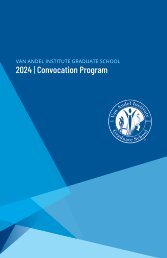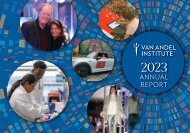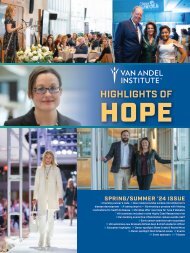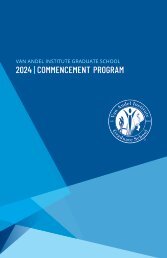2016 Scientific Report
You also want an ePaper? Increase the reach of your titles
YUMPU automatically turns print PDFs into web optimized ePapers that Google loves.
STEFAN JOVINGE, M.D., PH.D.<br />
Dr. Jovinge received his M.D. (1991) and his Ph.D. (1997) at<br />
Karolinska Institute in Stockholm. Since December 2013 he has<br />
been the Medical Director of Research at the Frederik Meijer Heart<br />
and Vascular Institute and a Professor at VARI. He also directs<br />
the DeVos Cardiovascular Research Program, is a Professor at the<br />
MSU College of Human Medicine, and is a Consulting Professor at<br />
Stanford University.<br />
STAFF<br />
PAULA DAVIDSON, M.S.<br />
DAWNA DYLEWSKI, B.S.<br />
ELLEN ELLIS<br />
EMILY EUGSTER, M.A.<br />
JENS FORSBERG, PH.D.<br />
LISA KEFENE, M.A., MB(ASCP), RLAT<br />
ERIC KORT, M.D.<br />
BRITTANY MERRIFIELD, B.S.<br />
HSIAO-YUN YEH (CHRISTY) MILLIRON, PH.D.<br />
JORDAN PRAHL, B.S.<br />
LAURA TARNAWSKI, M.S.<br />
MATTHEW WEILAND, M.S.<br />
LAURA WINKLER, PH.D.<br />
RESEARCH INTERESTS<br />
The DeVos Cardiovascular Research Program is a joint effort between VARI and<br />
Spectrum Health. The basic science lab is the Jovinge laboratory at VARI, and a<br />
corresponding clinical research unit resides within the Fred Meijer Heart and Vascular<br />
Institute.<br />
Cardiovascular diseases are among the major causes of death and disability worldwide.<br />
While the incidence of ischemic heart diseases has started to decline, congestive heart<br />
failure is still rising. Medical treatment for the latter is supportive, and the only available<br />
therapy is heart transplantation.<br />
To regenerate myocardium after disease or damage is one of the major challenges in<br />
medicine. Our group is working on true heart muscle regeneration along two axes:<br />
external and internal (cardiac) cell sources. The most robust external source for<br />
generating heart muscle cells has been stem cells, either from an embryonic stem<br />
cell (ESC) system or from reprogrammed pluripotent stem cells (iPSCs). The main<br />
drawback to the stem cell approach is that their differentiation will generate a multitude<br />
of different cell types at different stages of development. A mixed cell population of<br />
undifferentiated cells always has the potential to create tumors. Also, the use of ESCs<br />
creates a need for lifelong immunosuppressive treatment. iPSCs, however, could be<br />
generated from the patient’s own peripheral blood cells, a technique established by our<br />
group in Grand Rapids. To be able to use these sources, we have developed strategies<br />
based on establishing surface marker expression—similar to those for bone-marrow<br />
cells—to help select homogenous, safe populations to transplant.<br />
34 Van Andel Research Institute | <strong>Scientific</strong> <strong>Report</strong>

















